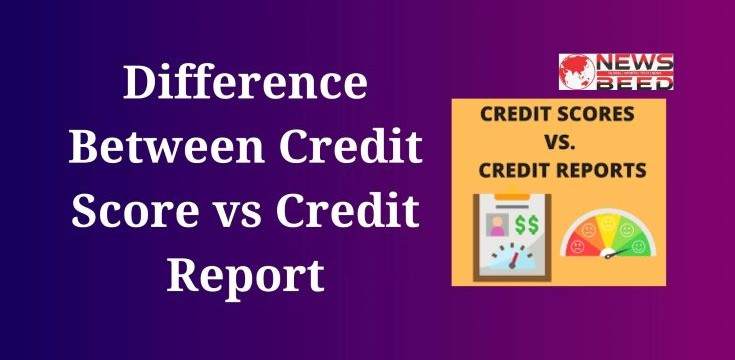A credit score is a numerical representation of an individual’s creditworthiness, while a credit report is a detailed record of their credit history. The credit score is a quick snapshot, usually ranging from 300 to 850, indicating the likelihood of timely repayments, while the credit report provides a comprehensive account of a person’s financial behavior, including accounts, payment history, and public records. Lenders use both to assess a borrower’s risk and make lending decisions.
Difference Between Credit Score vs Credit Report
A credit score and a credit report are two distinct but interrelated concepts that play a crucial role in the world of personal finance. They both provide information about an individual’s creditworthiness, which lenders use to assess the risk of lending money to that person. However, they serve different purposes, are generated through different methods, and contain varying levels of detail. In this comprehensive explanation, we will delve into the differences and relationships between credit scores and credit reports, providing a thorough understanding of both concepts.
Credit Report
What is a Credit Report?
A credit report is a detailed record of an individual’s financial history and credit-related activities. It is a comprehensive document that summarizes an individual’s credit accounts, payment history, public records, and inquiries. Credit reports are maintained by credit bureaus, also known as credit reporting agencies, which collect and update information about consumers’ credit activities from various sources.
Contents of a Credit Report
- Personal Information: A credit report begins with your personal information, including your name, address, date of birth, and Social Security number. This section helps ensure that the report accurately pertains to you.
- Credit Accounts: This section lists your various credit accounts, including credit cards, loans, and mortgages. Each account is described in detail, including the lender’s name, account number, type of account, credit limit, and outstanding balance.
- Payment History: Your payment history is a critical component of your credit report. It details your payment behavior on each credit account, indicating whether you’ve made payments on time, missed payments, or defaulted on any accounts.
- Public Records: If you have any legal or financial judgments against you, such as bankruptcies, tax liens, or civil judgments, they will be listed in the public records section.
- Inquiries: The report includes a list of entities that have requested your credit report. There are two types of inquiries: hard inquiries and soft inquiries. Hard inquiries occur when a lender reviews your report as part of a credit application, while soft inquiries are typically related to background checks or your own monitoring of your credit.
Also, Read This: What is Digital Marketing in Hindi
How Is a Credit Report Used?
Credit reports serve several essential purposes:
- Credit Decisioning: Lenders and creditors use credit reports to assess the creditworthiness of individuals applying for credit. They review the information in your credit report to determine the risk associated with lending you money and to make decisions about interest rates, credit limits, and whether to approve or deny an application.
- Interest Rate Determination: Your credit report plays a significant role in determining the interest rates you are offered on loans and credit cards. Those with higher credit scores generally receive lower interest rates, saving them money over time.
- Employment and Rental Applications: Some employers and landlords may request permission to check your credit report as part of their application process. They do this to assess your financial responsibility and trustworthiness.
- Insurance Premiums: In some cases, insurance companies use credit reports to determine premiums for auto, home, or other types of insurance. A higher credit score may lead to lower insurance premiums.
- Identity Verification: Credit reports can be used to verify an individual’s identity in various situations, such as when opening a bank account or applying for government benefits.
Access to Your Credit Report
Under the Fair Credit Reporting Act (FCRA) in the United States, consumers have the right to request a free copy of their credit report from each of the three major credit bureaus (Equifax, Experian, and TransUnion) once every 12 months. Additionally, individuals are entitled to a free copy of their credit report if they have been denied credit, employment, or insurance due to information in the report. Regularly reviewing your CR is important to identify errors and monitor your credit health.
Credit Score
What Is a Credit Score?
A credit score is a three-digit numerical representation of an individual’s creditworthiness. It condenses the information in a credit report into a single number that provides a quick assessment of a person’s ability to manage credit and repay debts. Credit scores are used by lenders to make rapid lending decisions and are considered a reliable indicator of risk.
How Is a Credit Score Calculated?
Credit scores are generated through mathematical algorithms and models that analyze the data in a credit report. While there are various credit scoring models, the FICO score and the VantageScore are the most commonly used in the United States. These models consider multiple factors, each with its own weight:
- Payment History (35%): The most influential factor, payment history, assesses whether you’ve made payments on time, had late payments, or defaulted on loans.
- Amounts Owed (30%): This factor looks at the total amount of debt you owe, your credit utilization ratio (credit card balances relative to credit limits), and the number of accounts with outstanding balances.
- Length of Credit History (15%): This factor evaluates the age of your credit accounts and the average age of all your accounts.
- Credit Mix (10%): Credit scoring models consider the variety of credit accounts you have, such as credit cards, installment loans, and mortgages.
- New Credit (10%): This factor looks at how frequently you’ve applied for new credit accounts. Numerous recent credit inquiries can have a negative impact on your score.
Credit Score Range
Both FICO and Vantage Score credit scores have a range that typically falls between 300 and 850, with higher scores indicating better creditworthiness. The specific range may vary slightly depending on the scoring model. Here’s a general guideline for interpreting credit scores:
- 300-579: Poor
- 580-669: Fair
- 670-739: Good
- 740-799: Very Good
- 800-850: Excellent
How Is a Credit Score Used?
Credit scores have a wide range of applications:
- Lending Decisions: Lenders use credit scores to assess the risk of lending to an individual. A higher credit score often leads to more favorable lending terms, such as lower interest rates and higher credit limits.
- Credit Card Approvals: Credit card companies use credit scores to determine whether to approve an applicant for a credit card and what credit limit to offer.
- Interest Rates: Credit scores directly impact the interest rates borrowers are offered on loans and credit cards. A higher credit score generally leads to lower interest rates, saving borrowers money.
- Renting an Apartment: Landlords may use credit scores to evaluate rental applications, as a good credit score is often associated with financial responsibility.
- Insurance Premiums: Insurance companies may use credit scores to set premiums for policies, with lower scores sometimes resulting in higher premiums.
- Employment: Some employers, particularly in positions involving financial responsibility, may check credit scores as part of the hiring process.
- Utility Deposits: Utility companies may use credit scores to determine whether a new customer needs to pay a security deposit for services.
Differences and Relationships
Now that we’ve explored credit reports and credit scores individually. Let’s delve into the key differences between the two concepts and how they are interconnected.
-
Data vs. Score:
-
- Credit Report: A credit report contains a detailed record of your financial history, including your credit accounts, payment history, and public records. It serves as a comprehensive repository of your credit-related information.
- Credit Score: A credit score is a numerical representation of your creditworthiness. It condenses the information from your CR into a single number, making it easier for lenders to assess your credit risk quickly.
-
Purpose:
-
- Credit Report: The primary purpose of a credit report is to provide a detailed history of your financial activities. It is a comprehensive document that offers a holistic view of your credit behavior.
- Credit Score: Credit scores are designed to provide a quick, standardized assessment of your creditworthiness. Lenders use these scores to make rapid lending decisions.
-
Use in Lending Decisions:
-
- Credit Report: Lenders use credit reports to evaluate an individual’s credit history in detail. They review the report to assess payment behavior, account history, and any derogatory marks.
- Credit Score: Lenders use credit scores as a shortcut to assess credit risk. It provides a numerical summary of an individual’s creditworthiness, helping lenders make faster lending decisions.
Read Also:- What is Chatgpt Step by Step
-
Access:
- Credit Report: Under the FCRA, consumers are entitled to a free copy of their credit report from each of the three major credit bureaus once a year. You can also receive a free report. If you’ve been denied credit or experienced adverse action due to your CR.
- Credit Score: While consumers can access their credit scores. They are not typically provided for free through the same annual CR process. Credit scores can be obtained through various services or lenders.
-
Composition:
- Credit Report: A credit report contains detailed information about your personal information, credit accounts, payment history, public records, and inquiries.
- Credit Score: A credit score is a single numerical value. Typically ranging from 300 to 850. Derived from a mathematical algorithm that considers specific factors in your credit report.
-
Factors Considered:
- Credit Report: A CR provides a wide array of data, including personal information, credit account details, and payment history. It offers a comprehensive overview of your credit activities.
- Credit Score: A credit score condenses the information from your credit report into a single number, considering key factors like payment history. Amounts owed, length of credit history, credit mix, and new credit.
-
Variability:
- Credit Report: While credit reports may contain errors or outdated information. They are generally more stable and less prone to frequent changes.
- Credit Score: Credit scores can fluctuate more frequently because they are calculated using dynamic models and algorithms. They can change as new information is added to your CR.
-
Immediate vs. Historical:
- Credit Report: A credit report provides historical information, reflecting your credit activities and payment history over time.
- Credit Score: A credit score offers an immediate snapshot of your creditworthiness at the time it is calculated.
-
Interdependence:
- Credit Report and Credit Score: Credit scores rely on the data in your CR. A change in your CR, such as a missed payment or the opening of a new credit account, can impact your credit score. In other words, your credit score is a reflection of the information in your CR.
-
Customization:
- Credit Report: Credit reports are standardized documents provided by credit bureaus. They contain factual information and are not customized for specific purposes.
- Credit Score: Lenders may use different credit scoring models and customize. Their credit score requirements based on their lending policies and the type of credit they offer.
Conclusion:
Credit reports and credit scores are essential tools in the world of personal finance. A credit report is a detailed record of your credit history. While a credit score is a numerical representation of your creditworthiness. Lenders use both to assess the risk of lending to you and determine the terms of credit they offer. It’s important to regularly review your CR for accuracy and understand how your credit behavior impacts your credit score. By maintaining a positive credit history and a good credit score. You can access better financial opportunities and save money on borrowing costs.




